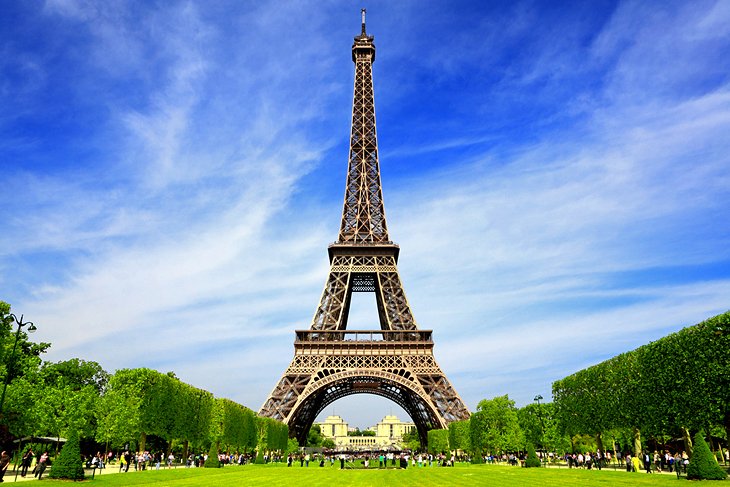Whether sunshine is sparkling on the café terraces of Boulevard Saint-Germain or melancholy mists of the Seine River are shrouding Notre-Dame Cathedral, the magical ambience of Paris has a way of romancing visitors. This incomparable city is filled with grandiose monuments like the Eiffel Tower, the Arc de Triomphe, and the Panthéon. Yet the charm of Paris lies in the small details: the quaint cobblestone streets, perfectly manicured trees, dainty tea salons, Belle Epoque brasseries, and avant-garde art galleries. Like a veritable open-air museum, the city’s buildings are works of art, and the Parisians’ everyday fashion is worthy of a magazine spread.
A world of discovery awaits in the distinctive quartiers (neighborhoods): the winding labyrinth of old streets in the medieval Latin Quarter, the legendary café scene in Saint-Germain-de-Prés, and the Bohemian village atmosphere of Montmartre. In every hidden corner and at all the famous sites, Paris casts a spell of enchantment. One visit may inspire a lifelong love affair. Find the best places to visit in this magical city with our list of the top tourist attractions in Paris.
1. Eiffel Tower
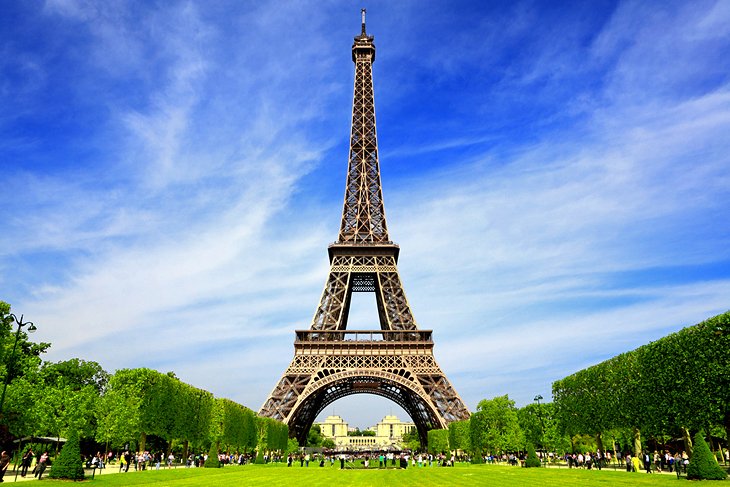
The most visited tourist attraction in Paris, the Eiffel Tower also ranks high on the list of places to visit in France. It’s hard to believe that the structure was dismissed as a monstrosity when it was first unveiled. The iconic tower was designed by Alexandre-Gustave Eiffel for the Paris Exhibition of 1889, which marked the centenary of the French Revolution.
The tower consists of 18,000 sturdy iron sections (weighing over 10,000 tons) held together by 2.5 million rivets. This innovative structure is now considered a masterful architectural feat and is the most emblematic sight in Paris. From the Jardins du Trocadéro and the lawns of the Champs de Mars, there is just the right distance from the Eiffel Tower for a picture-perfect photo-op. Reaching 324 meters in height, the tower was the world’s tallest building until the Empire State Building was erected.
Visitors can take an elevator or walk up the 360 steps to arrive at the first level (at 57 meters) and 344 more steps to the second level (at 115 meters). The outlooks from both the first and second level are spectacular. To reach the top level, at the dizzying elevation of 276 meters, requires an exhilarating elevator ride from the second level. Visiting the top level is one of the most thrilling things to do in Paris, but it’s not for the faint of heart.
For those who’d like to indulge in a gourmet meal, the Jules Verne Restaurant is on the second floor. This restaurant features expansive windows, which allow diners to enjoy the amazing panoramas.
It’s best to purchase tickets in advance especially if visiting during high season. To ensure the best experience possible, tourists can sign up for the Eiffel Tower Priority Access Tour. This one-hour tour allows tourists to avoid standing in several long lines and offers the added benefit of educational commentary. A knowledgable guide will share interesting information and provide historical context.
2. Musée du Louvre
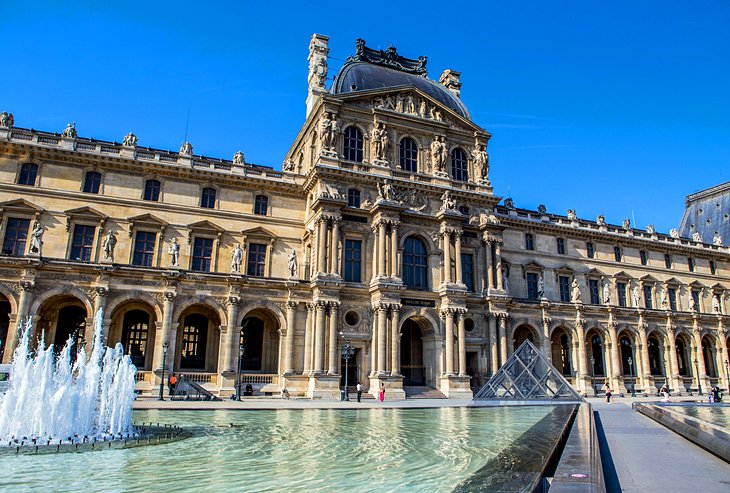
A sumptuous palace that was once the home of France’s Kings, the Louvre is the most important of Paris’ top museums. Visitors enter the museum in the courtyard of the palace at the glass pyramid (designed by Ieoh Ming Pei in 1917). The Louvre Museum possesses more than 30,000 artworks (many considered masterpieces)—from antiquities to European paintings of the 15th to 19th centuries.
It is impossible to see it all in one visit, but tourists can focus on a particular gallery, such as classical sculpture, Italian Renaissance art, or 17th-century French paintings, or take a self-guided tour to see the Louvre Museum’s highlights.
The most famous piece is the Mona Lisa or La Gioconda (or La Joconde in French) painted by Leonardo da Vinci in 1503-1505. Other exceptional works are the ancient Venus de Milo sculpture, the monumental Victory of Samothrace of the Hellenistic period, the immense Wedding Feast at Cana painting by Veronese (1563), and Botticelli’s frescoes. Also a must-see is Liberty Leading the People (1831) by Eugène Delacroix, depicting the Parisian uprising of July 27th to 29th, 1830 known as “Trois Glorieuses” (“Three Glorious Days”).
To get the most out of a visit to the Louvre, tourists can take a guided tour. The Skip the Line: Louvre Museum Tour allows participants to jump ahead of the long queues and head straight to the museum’s most famous artworks, including the Venus de Milo and the Mona Lisa. On this three-hour tour, a knowledgeable guide discusses the collections, explains interesting information about the paintings, and answers questions.
The Louvre is surrounded on one side by the Jardin des Tuileries, one of the largest and loveliest parks in Paris. The celebrated landscape architect André Le Nôtre (who designed the gardens of Versailles) created the Tuileries Gardens in classic French style. The formal gardens feature perfectly manicured trees; two ponds; and statues by Rodin, Giacometti, and Maillol. Park benches offer a place to relax and enjoy the scenery. There are also several café-restaurants with outdoor seating.
3. Cathédrale Notre-Dame de Paris
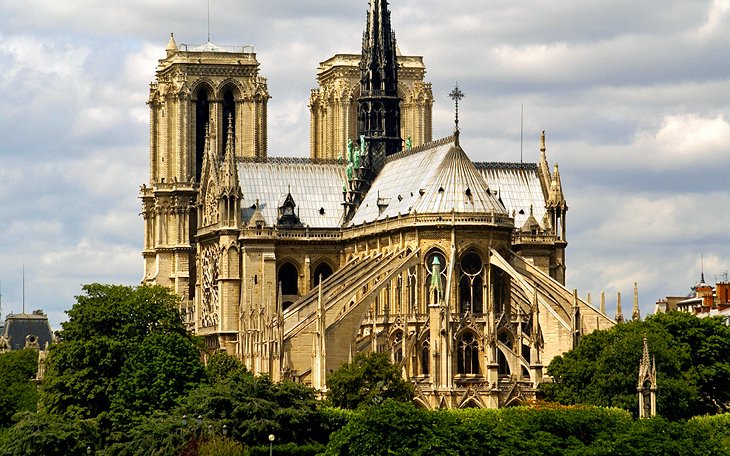
A triumph of Gothic architecture, the Notre-Dame stands in the heart of Paris on the Ile de la Cité near the attractions of the Latin Quarter. An island in the Seine River, the Ile de la Cité is the historical and geographical center of Paris. On this small plot of land, the Romans built the Gallo-Roman city of Lutetia, and from the 6th century to the 14th century, the Kings of France resided here.
The Notre-Dame Cathedral was founded in 1163 by King Louis IX (Saint Louis) and Bishop Maurice de Sully, and the construction took more than 150 years. The cathedral was first created in Early Gothic style, while later additions (the west front and the nave) show the transition to High Gothic style. Tourists are immediately struck by the ornamental design of the facade, with its profusion of sculptures and gargoyles, while elaborate flying buttresses provide structural integrity for the enormous building. Look out for the 21 figures above the doorway in the Gallery of Kings, who lost their heads during the Revolution. (The heads are now on display in the Musée de Cluny.)
After admiring the decorative doorway, enter the sanctuary to take in the grandeur of this immense vaulted space. The sanctuary seems almost endless and beckons visitors with the light of flickering candles. The interior is illuminated by magnificent stained-glass windows. The most noteworthy window is the rose window in the north transept. This stunning work of art features 80 Old Testament scenes centered around the Virgin.
Note: In April of 2019, a fire caused considerable damage to the cathedral. The interior is closed to the public. The structure will be undergoing repairs in the years ahead.
4. Avenue des Champs-Élysées
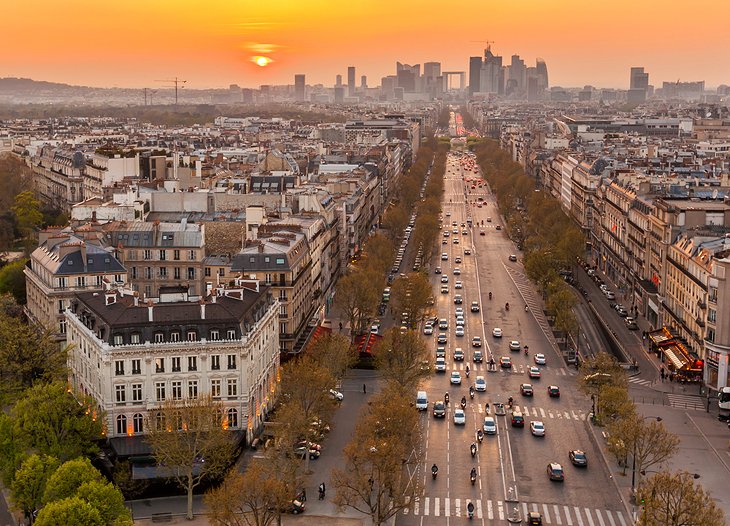
The most monumental boulevard in Paris used to be a desolate field of marshland until the 17th century, when it was landscaped by André Le Nôtre. A century later, the renowned Parisian city planner Baron Haussman designed the boulevard’s elegant buildings. The Champs-Elysées is divided into two parts with the Rond-Point des Champs-Elysées as its intersection.
The lower part of the Champs-Elysées, bordering the Place du Concorde, includes a spacious park, the Jardin des Champs-Élysées, and the Petit Palais fine arts museum. The upper part, extending to the Arc de Triomphe, is lined by luxury shops, hotels, restaurants, cafés, cinemas, and theaters. This bustling area draws many tourists and is a gathering place for Parisians.
The Champs-Elysées is famous for its prestigious establishments, such as Maison Ladurée (75 Avenue des Champs-Elysées), a pâtisserie shop renowned for its 18th-century tea salon and delicious pastries (their specialty is “macarons”), and upscale designer boutiques like Tiffany & Co. (62 Avenue des Champs-Élysées), Louis-Vuitton (101 Avenue des Champs-Elysées), and Cartier (154 Avenue des Champs-Élysées).
For fine dining, the top choices are the legendary “brasserie du luxe” restaurant and hotel Le Fouquet’s (99 Avenue des Champs-Élysées) and the swanky gastronomic restaurant L’Atelier Étoile de Joël Robuchon (82 Avenue Marceau, at the upper part of the Champs-Elysées near the Arc de Triomphe), which boasts a Michelin star.
Although the Champs-Elysées has an image of refinement, there are many affordable places that cater to tourists and students on a budget, such as the Disney toy store, H&M clothing shop, Starbucks, Quick, Burger King, and McDonald’s.
Address: Champs-Elysées, 75008 Paris (Métro: Champs-Élysées Clemenceau station to visit the Jardin des Champs-Élysées and Petit Palais, Franklin d. Roosevelt station for Laduree, George V station for the main shopping area).
5. Musée d’Orsay
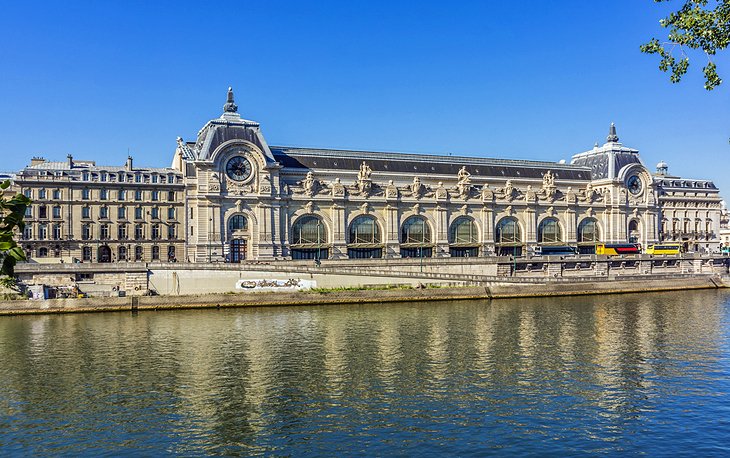
This splendid collection of Impressionist art is beautifully presented in an expansive space (formerly the Belle Epoque-era Gare d’Orsay railway station). The collection represents the work of all the masters of Impressionism. The artists range from classic Impressionist masters Edgar Degas, Edouard Manet, Claude Monet, and Pierre-August Renoir to Post-Impressionist artists such as Pierre Bonnard, Paul Cézanne, and Vincent van Gogh; the Pointillists (Georges Seurat, Paul Signac); and Bohemian artists like Toulouse Lautrec.
Some of the museum’s most famous pieces include Claude Monet’s The Magpie, Gare Saint-Lazare, Poppy Field, and Luncheon on the Grass; Vincent van Gogh’s self-portrait and Starry Night; and Renoir’s Dance at Moulin de la Galette, which depicts a festive party scene in Montmartre.
The Orsay Museum is among the best places to visit in Paris to get an overview of Impressionist art history—from the gentle brush strokes of Monet to the wild, colorful scenes of Gauguin. The museum also has two cafés and an upscale restaurant, which is worth the splurge. Formerly part of the Hôtel d’Orsay and listed as a Historic Monument, the museum’s restaurant features gilded ceilings and sparkling chandeliers.
6. Palais Garnier, Opéra National de Paris
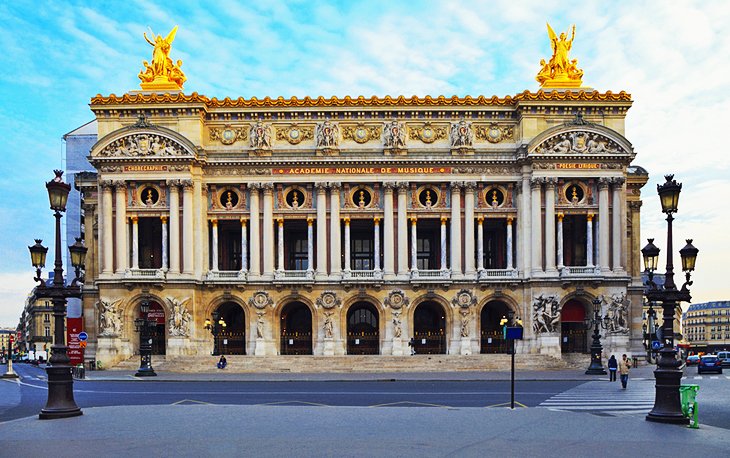
Commissioned by Napoleon III in 1860, the Palais Garnier Opera House was designed by Charles Garnier in an exuberant Baroque style. Garnier worked tirelessly on the project for over a decade, from 1862 to 1875. Today, the opulent monument is a symbol of Napoleon’s Imperial regime.
The facade features classical columns and eight sculptures representing allegorical figures: Poetry, Music, Idyll, Recitation, Song, Drama, and Dance. The loggia depicts busts of composers, including Rossini, Beethoven, and Mozart, while the cupola is topped with a statue of Apollo with allegorical figures of Poetry and Music. Upon entering the building, visitors are dazzled by the lavish 11,000-square-meter interior. Most of the building’s space is dedicated to the grand foyer with its fabulous Grand Escalier, marble entrance staircase, adorned by ornate gilded lamps.
The auditorium has an intimate feel, although it can accommodate 2,105 people in its plush red-velvet seats. Gilded balconies, an enormous crystal chandelier, and a Chagall ceiling painting add to the theater’s marvelousness, creating the perfect dramatic backdrop for cultural performances.
For visitors looking for things to do at night in Paris, the Opéra Garnier hosts a prestigious calendar of events. Besides opera, there are ballet performances, classical music concerts, and gala events. Attending a performance is a wonderful way to see the building’s interior and enjoy a glamorous evening. Another option is to visit during the daytime (entry ticket required).
For a deeper understanding of the Paris Opera House and its rich cultural heritage, tourists should visit the Bibliotèchque-Musée de l’Opera (Library-Museum of the Opera House) located inside the building. The library and museum contain three centuries of archives, as well as exhibits dedicated to the art of opera. The museum’s permanent collection features drawings of costumes and scenery, scale models, and paintings of the building. The Opera House also has a boutique and a stylish contemporary restaurant, which serves Japanese-French fusion cuisine.
7. Place de la Concorde
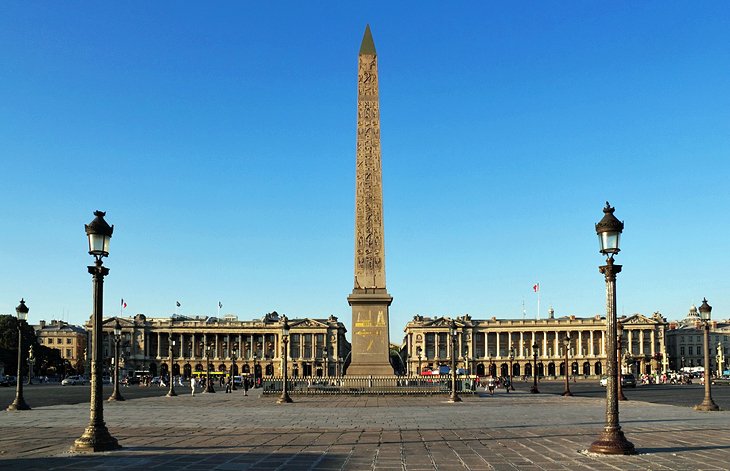
Created between 1755 and 1775 by the architect of King Louis XV, this impressive octagonal square is at the heart of 18th-century Paris. With its majestic dimensions, the Place de la Concorde is one of the most attractive squares in the city. It was the scene of several key historical events, including the execution of King Louis XVI, and it was part of Napoleon’s triumphal route.
The square offers sensational views of the triumphal route towards the Arc de Triomphe and the Défense, and towards the Louvre, as well as to the Madeleine and the Palais-Bourbon. At the center is an Egyptian obelisk, which was presented to Charles X by the Viceroy of Egypt. During summer, there is a Ferris wheel here.
The Place de la Concorde is a busy intersection with heavy traffic, circulating at high speeds. French drivers don’t always pay attention to pedestrians, so tourists should make sure to get out of the way! To arrive at the Place de la Concorde, walk from the Louvre through the Jardin du Tuileries or the Rue du Rivoli, or follow the Quai along the Seine River. Alternatively take the Métro to Concorde station.
8. Arc de Triomphe
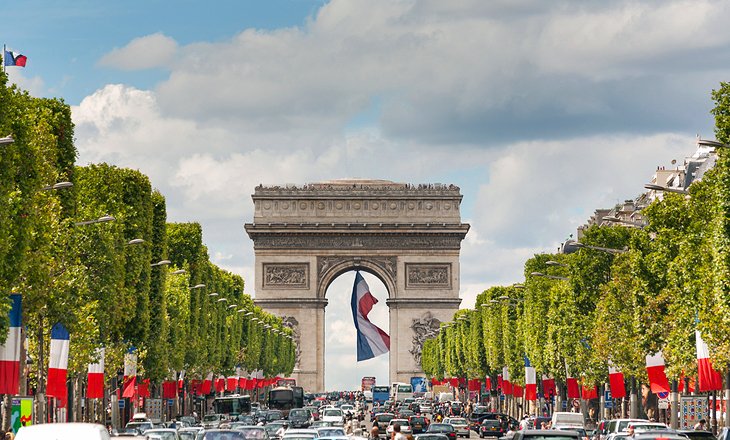
The Arc de Triomphe is dedicated to the soldiers who fought in the French armies of the Revolution and the First Empire (Napoleonic Wars). Napoleon commissioned the building of this mighty structure in 1806 but did not live to see its completion in 1836. Designed by JF Chalgrin, the massive 50-meter-high arch features bas-reliefs with larger-than-life-size figures, which depict the departure, victories, and glorious return of the French armies.
Particularly noteworthy is the bas-relief by François Rude on the Champs-Elysées-facing side: Departure of the Volunteers of 1792, also known as The Marseillaise, illustrating the troops led by the winged spirit of Liberty. On the inner surface of the arch are the names of more than 660 generals and more than a hundred battles.
From the top of the monument, a viewing platform affords panoramic views of the 12 avenues that radiate from the Place de l’Etoile, including the route from the Champs-Elysées to Place de la Concorde and the Louvre. It’s possible to see all the way to La Défense, Montmartre, and the Eiffel Tower.
At the foot of the Arc de Triomphe is the Tomb of the Unknown Soldier, dedicated in 1921 as a memorial to an anonymous soldier (symbol of the many other unknown soldiers who valiantly died for their country during World War One without ever receiving recognition). The Flame of Remembrance was ignited on November 11th, 1923 and since that date has not ever been extinguished. Every evening at 6:30pm, a ritual takes place to rekindle the memorial flame at the tomb.
Today, events to honor national holidays are held at the Arc de Triomphe, including the November 11th (anniversary of the Armistice of 1918) ceremony commemorating those who perished in the war; the May 8th Fête de la Victoire (Victory Day) celebrating the end of WWII, and the liberation from Nazi occupation; as well as festivities for July 14th (Bastille Day).
Guided tours of the Arc de Triomphe are available in English, French, and Spanish. Another option is to take a Skip-the-Line Tour, which allows quick access to the monument, avoiding the long queues.
Address: Place Charles-de-Gaulle, 75008 Paris (Métro: Charles-de-Gaulle-Etoile)
9. Seine River Cruises
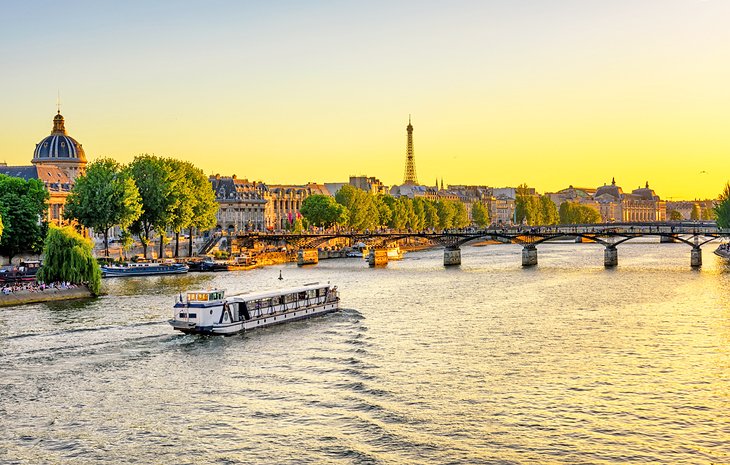
To truly soak up the alluring ambience of Paris, tourists should try taking a boat cruise along the Seine River. Besides being one of the most enjoyable things to do while visiting the city, Seine River Cruises allow tourists to see the sights from a different perspective. The Seine River bridges, Eiffel Tower, Notre-Dame Cathedral, and the Louvre Museum look stunning from the viewpoint of a riverboat.
While a daytime cruise allows tourists to appreciate the glory of the monuments brightened by sunshine, the most romantic experience is an evening cruise. After sunset, the city’s landmarks are illuminated, which creates a special effect, and somehow the city seems more magical. For a cruise that includes dinner, try the Bateaux Parisiens Seine River Cruise. This four-hour sightseeing journey departs near the Eiffel Tour, and guests are treated to a gourmet three-course meal.
10. Musical Concerts at Sainte-Chapelle
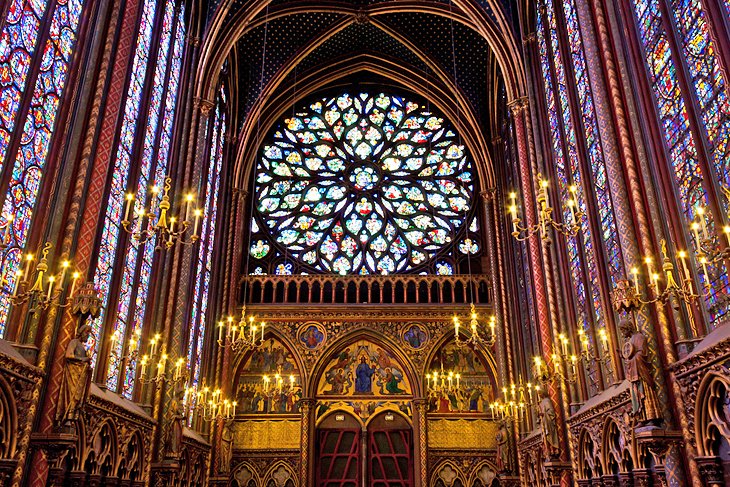
Sainte-Chapelle is rarely used for mass but often serves as a venue for music concerts. Listening to a choir or classical music performance in this space is an inspiring spiritual experience. Sainte-Chapelle is considered a rare jewel among medieval houses of worship and is certainly one of the most exquisite churches in Paris.
This masterpiece of Rayonnant Gothic architecture was built from 1242 to 1248 for King Louis IX (Saint Louis) to house the precious relics he had acquired from the Byzantine Emperor. The altar displays a relic of the Crown of Thorns.
The chapel is renowned for its breathtaking stained-glass windows, which give the sanctuary an iridescent glow and serene aura. (It’s recommended to visit in the morning and especially on sunny days to appreciate the windows at their most brilliant.) The chapel has 15 stained-glass windows (covering 600 square meters) depicting over 1,000 scenes from the bible, both Old Testament and New Testament stories. The colors and light symbolize divinity and the Heavenly Jerusalem.
Sainte-Chapelle is located in the Palais de la Cité. To find the chapel, enter the iron gate of the Palais de Justice and walk through the inner courtyard. Guided tours are available every day between 11am and 3pm.
Another attraction nearby is La Conciergerie (tourists may purchase combined entry tickets).
Address: 8 Boulevard du Palais, 75001 Paris (Métro: Cité, Saint-Michel or Châtelet station)

